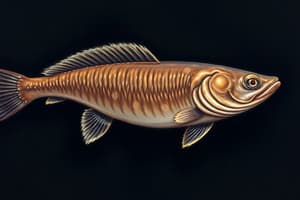Podcast
Questions and Answers
To what class do hagfish belong?
To what class do hagfish belong?
Class Myxini
Unlike parasitic lamprey, what are hagfish considered?
Unlike parasitic lamprey, what are hagfish considered?
Scavengers and predators
How does a hagfish enter a dead or dying animal?
How does a hagfish enter a dead or dying animal?
Through an orifice or by digging inside
Since hagfish do not have jaws, how do they 'bite' off the flesh of their prey?
Since hagfish do not have jaws, how do they 'bite' off the flesh of their prey?
To gain more leverage while being eaten, what do hagfish do?
To gain more leverage while being eaten, what do hagfish do?
What are hagfish known for having the ability to create when disturbed?
What are hagfish known for having the ability to create when disturbed?
Unlike other vertebrates, how are the body fluids of hagfish different?
Unlike other vertebrates, how are the body fluids of hagfish different?
What are some peculiarities with hagfish's anatomy?
What are some peculiarities with hagfish's anatomy?
What gender of hagfish outnumbers the other?
What gender of hagfish outnumbers the other?
What is reproduction like in female hagfish?
What is reproduction like in female hagfish?
In the development of hagfish, what is missing?
In the development of hagfish, what is missing?
Flashcards are hidden until you start studying
Study Notes
Hagfish Classification and Behavior
- Hagfish belong to Class Myxini, distinguishing them from other fish types.
- Unlike parasitic lamprey, hagfish are scavengers and predators, primarily feeding on dead or dying animals.
- They enter their prey through an orifice or dig inside to access the flesh.
Feeding Mechanism
- Hagfish lack jaws; they "bite" using two toothed, keratinized plates on their tongue.
- To gain leverage while feeding, hagfish tie their tails in a knot, pushing the knot forward against their prey.
Unique Defensive and Physiological Features
- When disturbed, hagfish can produce large amounts of milky slime as a defense mechanism.
- Their body fluids exist in osmotic equilibrium with seawater, which is atypical for vertebrates.
- An anatomical peculiarity includes a low-pressure circulatory system featuring three accessory hearts in addition to the main heart.
Reproduction and Development
- Female hagfish significantly outnumber males, with a ratio of 100 to 1.
- The reproductive habits of female hagfish remain a mystery, as they produce small quantities of large eggs measuring about 2-7 cm.
- Notably, hagfish do not undergo a larval stage during their development.
Studying That Suits You
Use AI to generate personalized quizzes and flashcards to suit your learning preferences.




